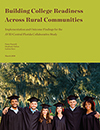Building College Readiness Across Rural Communities
Implementation and Outcome Findings for the AVID Central Florida Collaborative Study

 In the United States today, more jobs than ever before require at least some postsecondary education. Yet too many young adults are either not enrolling or not succeeding in college. This scenario exists across many different types of communities, but schools in rural areas, particularly those with large populations of low-income students, face unique challenges in preparing and inspiring students to attend college. To address these challenges, the AVID (Advancement Via Individual Determination) Center — a nonprofit organization working to close the achievement gap for minority and low-income students — partnered with three rural school districts and the local state college in central Florida to develop and implement programming focused on strengthening college preparedness among middle school and high school students. Supported by funds from an Investing in Innovation (i3) development grant from the U.S. Department of Education, the partners worked together to implement the AVID College Readiness System (ACRS) across eight schools, train secondary and postsecondary instructors in a shared set of teaching strategies and best practices, strengthen the academic rigor of their classes, and develop a set of “alignment activities” for school staff members focused on collaboration and consistency of teaching and study strategies across middle school, high school, and college.
In the United States today, more jobs than ever before require at least some postsecondary education. Yet too many young adults are either not enrolling or not succeeding in college. This scenario exists across many different types of communities, but schools in rural areas, particularly those with large populations of low-income students, face unique challenges in preparing and inspiring students to attend college. To address these challenges, the AVID (Advancement Via Individual Determination) Center — a nonprofit organization working to close the achievement gap for minority and low-income students — partnered with three rural school districts and the local state college in central Florida to develop and implement programming focused on strengthening college preparedness among middle school and high school students. Supported by funds from an Investing in Innovation (i3) development grant from the U.S. Department of Education, the partners worked together to implement the AVID College Readiness System (ACRS) across eight schools, train secondary and postsecondary instructors in a shared set of teaching strategies and best practices, strengthen the academic rigor of their classes, and develop a set of “alignment activities” for school staff members focused on collaboration and consistency of teaching and study strategies across middle school, high school, and college.
The i3 grant also includes an evaluation, conducted by MDRC, of implementation and outcomes over the first three years of the project. The implementation study examines how closely the implementation of the ACRS hewed to the model design and examines the drivers of and obstacles to its success. The outcomes study uses a “pre-post” nonexperimental method (which does not capture causation) to compare both school staff outcomes and student outcomes before implementation with outcomes during the implementation years to explore the promise of the system to positively affect schools and students. The report presents several key findings:
-
Overall, analyses show that the ACRS was implemented successfully at most schools with fairly high fidelity to the model. There was mixed success implementing the alignment activities.
-
Positive change was seen in teachers’ reported use of most ACRS teaching strategies, and in teachers’ and other staff members’ reported attitudes toward academic rigor and college preparation for all students and reported collaboration within and across grade levels and schools.
-
Little difference was found between the reported study habits and learning skills, engagement in school, and postsecondary expectations of students surveyed before implementation and of those surveyed after three years of exposure; however, on average, both groups had relatively high positive responses on most of the measures.
-
Students were more likely to take advanced courses, such as honors and Advanced Placement, and earned more credits in these courses, which are intended to strengthen their preparation for the rigor of college work.
- Little difference in other measures of students’ academic performance (grade point average and English Language Arts standardized tests), educational attainment (overall credits earned and graduation), and high school persistence were found after three years of implementation compared with the outcomes before implementation.







